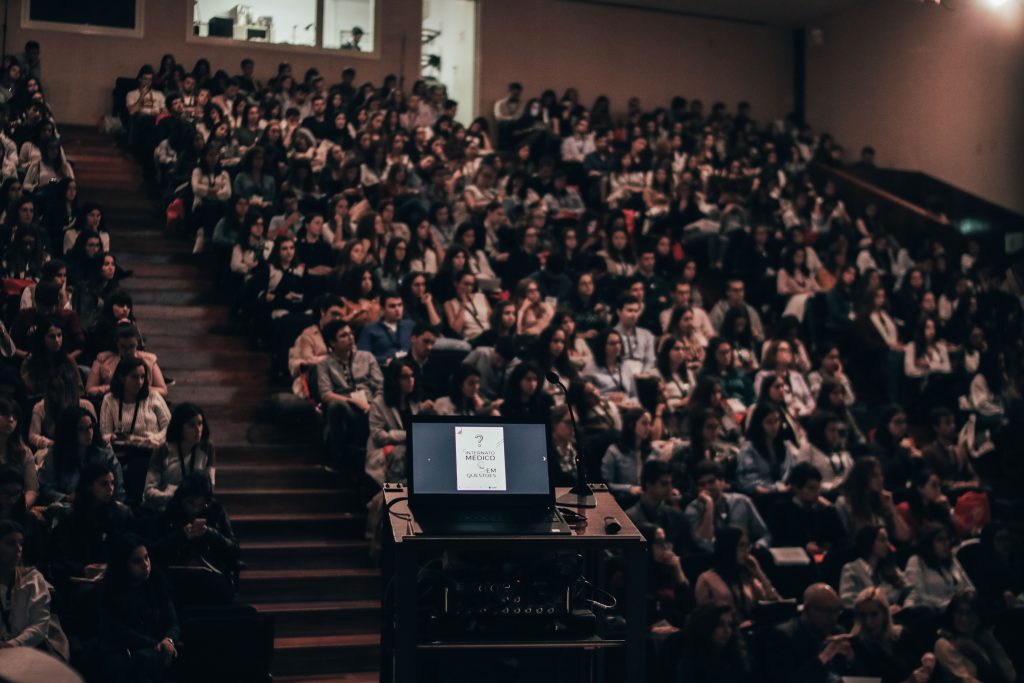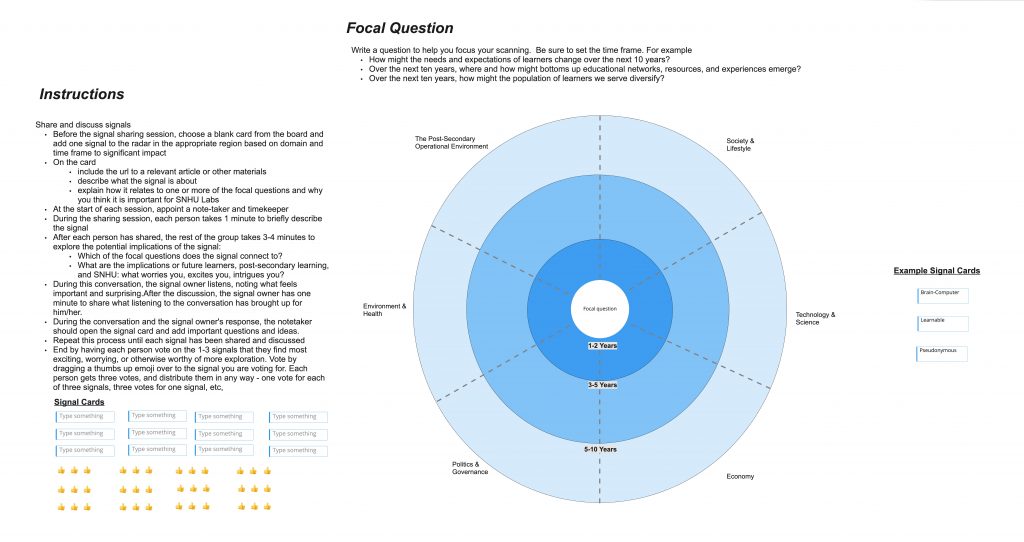Published on
An Opportunity Narrative: The Future of Learning Is Now

The pandemic forced the acceleration of a major paradigm shift in higher education.
The hybrid learning environment is here to stay. At the same time, a whole new generation of learners—Gen Z—are raising the bar for what they expect from higher education. At the height of the pandemic, during a time of social distancing, 62% of nearly 3,000 teens ages 13 to 18 surveyed on the video game Roblox (2020) reported using game platforms to interact with friends. Also compelling is that video viewership showing game play has surged, with Among Us reaching 4 billion views on YouTube on September 4, 2020. As Michelle Miller, President, and Co-Founder of Games and Learning, explained to a Southern New Hampshire University (SNHU) audience, Gen Z is redefining the use of digital platforms in a way that departs from their intended purposes. Such signals point to the need to reorchestrate the classroom of the future. Yet very few higher education institutions are ready to meet Gen Z’s expectations for the future of teaching and learning.
Higher education is still scrambling.
I have been focused on helping higher education understand how to engage this new generation of learners since 2018, the year when the youngest of Gen Z entered first grade. Recently, I have had the opportunity to collaborate with Dr. Jim Catanzaro, Executive Director of HERDI South, and community college presidents in roundtable discussions on the future of learning organized by the Association for College and University Educators (ACUE). Due to falling enrollment numbers, many presidents see the need to reimagine higher education, but engaging Gen Z is their challenge—an important challenge given the negative impact of the pandemic on youth mental health, math and reading test scores and child development.
First, consider strategy.
The Department of Education released a strategy to redesign U.S. high schools to reduce inequality in postsecondary enrollment. In turn, this will require postsecondary institutions to be open to change and consider equitable pathways to admission. It is probable that young Gen Z will soon expect credit for prior learning when enrolling in college.
Nonetheless, it is difficult to predict the future accurately. In addition to a three- or five-year strategic plan, various teams at SNHU and I have used Deloitte’s Center for the Edge’s Zoom Out Zoom In: An alternative approach to strategy in a world that defies prediction. It involves periodically zooming out and adopting a long-term view to continuously anticipate what students and the higher education industry need in five to ten years and then zooming back in and drilling down by experimenting with one to three initiatives and start making the changes necessary to attract this new generation without stepping on landmines.
- Zooming Out. Certified futurist, Steve Brown, founder of the Futures Collaborative, helps organizations, communities and individuals understand, embrace and work with the uncertainties of a rapidly changing world. He suggests that one internal capability leaders may want to grow is signal tracking. According to the Institute for the Future, “A signal is typically a small or local innovation or disruption that has the potential to grow in scale and geographic distribution.” Taken together, signals can help identify future trends when grounded in a systems-thinking framework, such as STEEP, which stands for social, technological, economic, environmental and political. This is the approach EDUCAUSE uses to identify trends and key technologies and practices shaping the future of teaching and learning.
Templates like the one below can help teams collect and explore the implications of signals from across the STEEP categories. ~ Steve Brown, Futures Collaborative

- Zooming In. One way of zooming back in is to take a few small bets and experiment. One should be prepared to break things and dismantle outdated ideas. This can grow one’s understanding of what new capabilities and requirements need to be put in place now to prepare for the future. Those who engage in fundamental science know that experimentation can lead one down a path of new discoveries and stimulate new ideas. I recommend Peter Sims’s Little Bets: How Breakthrough Ideas Emerge from Small Discoveries for more on the importance of incremental experimentation to develop new ideas.
Experimenting with the Metaverse. Joshua Burdick, a young Gen Z consultant, recently participated in several ACUE roundtables on the future of learning and suggested that leaders must think in ways that will capture his generation’s attention. One suggestion pertained to immersive technologies like virtual reality (VR) and the possibilities afforded by the metaverse for education. Colleges could prominently incorporate VR in their marketing to help prospective students envision how it feels to be in the college, on campus or enrolled in a given program, as well as perceive the college to be operating on the cutting edge. After students have matriculated, postsecondary educators might explore emerging models to make VR a reality in their classrooms.
In addition to VR, colleges may want to experiment with learning decentralized autonomous organizations popularly known as DAOs and encourage students to work with faculty in constructing their learning experiences—maximizing the dual benefits of collaborative and constructionism learning.
Those who may not know where to start with emerging technology can enlist the help of a Gen Z student on campus. It is likely that many students are already actively part of these communities. For example, Rabbit Hole rewards learners in crypto for helping build a small component of a product.
Second, I have heard from leaders that they are interested in ways to address fear of change and the unknown at their institutions. John Hagel in the Journey Beyond Fear encourages leaders to frame their organizational narrative in terms of moving toward opportunities and not in terms of avoiding a future threat. Social psychologists have long studied the goal achievement benefits of approach motivation versus avoidance motivation.
As former Executive Director of SNHU Labs, I have found creativity and innovation to flourish most when leaders strive to create a psychologically safe environment. According to Dr. Timothy R. Clark, “Psychological safety is an environment of rewarded vulnerability,” one where leaders welcome intellectual friction while taking steps to decrease social friction.
Communities of Practice (CoPs) are one way to foster psychological safety and nurture an innovative mindset. CoPs are typically characterized by a group of people dedicated to a shared passion, trying to solve a complex problem and pursuing collective learning through doing. By bringing together faculty and administrators from different departments, CoPs can be a powerful way to democratize the future of learning.
At SNHU, the goal of the Innovation CoP is to foster grassroots innovation and bring visibility to ideas. CoP members learn and practice tools for innovation and apply them to problems brought forth by different departments at the university. This allows members to both get experience using tools, utilize these tools to support department work and support the university at the same time. ~ Dr. Michelle Alvarez, Southern New Hampshire University
Today’s leaders may feel the need to be quick to action. However, I propose three guiding principles to consider prior to introducing change.
1. Inherently human interactions must be valued above all. In The Courage to Teach, Parker J. Palmer writes that students are marginalized people. Many students don’t speak up, seek help or enroll in college because they are afraid of sounding dumb or being rejected. This is especially true for minoritized or racialized—at risk of experiencing stereotype threat—learners. We now more than ever need educators who can “teach to their fearful hearts” because “their minds often come along as well.”
When faculty teach to students’ fearful hearts, they do what Jamie Merisotis, President of the Lumina Foundation, calls Human Work—inherently human skills that cannot be replaced by automation. However, AI could be quite powerful when used to augment faculty’s role and allow for more meaningful interactions between faculty and students. Work led by Seth Corrigan, a researcher now at the UC Irvine School of Information is helping higher education understand why faculty will need professional development to teach with AI, and organizations such as the EdSAFE AI Alliance are helping to develop common definitions, lead education initiatives to promote understanding and determine certification frameworks.
2. New technology should not be applied to a flawed current state and outdated practices. For example, research on instructor feedback practices in undergraduate writing conducted at SNHU with Pearson Education suggests addressing existing gaps between current and best practices in delivering feedback as an important step in understanding how to design an automated feedback system.
It is also important to resist applying emerging technologies to old practices. Just like the design firm IDEO is reimagining the future of the book, there is a need to also reimagine the future of the writing assignment, the future of the rubric and the future of other learning and assessment activities in a way that leverages the power of emerging technologies and transformative learning theories.
The future of adult learning is also Gen Z. Research conducted by Oxford Economics predicts Gen Z workers will triple by 2030. And in an age of lifelong learning due to the rapid pace of change in the workplace, Gen Z will be the adult learners of the future. It is therefore important to anticipate who Gen Z will be in the future as this generation evolves. Those building from scratch, such as the University of North Carolina System’s Project Kitty Hawk may have the leading advantage of not being tied to legacy issues and enabling institutions to quickly address the challenges adult learners of today and tomorrow face.
3. Creating conditions for self-determination is important in fostering motivation for change. Dr. Richard Koestner, Professor of Psychology and Director of McGill University’s Human Motivation Lab and one of my favorite professors, has published over 125 articles suggesting that controlling practices for human motivation are rarely effective. A transformative and collaborative leadership style is needed for transformation to occur in higher education.
Indeed, a large body of research in psychology has demonstrated that external rewards, deadlines and imposed goals can dampen one’s intrinsic motivation and impede progress toward change. To help faculty and administrators embrace the future of teaching and learning, this research grounded in self-determination theory suggests leaders work to create a workplace setting that promotes a sense of autonomy, competence and relatedness, which in turn will foster greater internalization of institutional goals and fuel performance.
Author Perspective: Administrator



